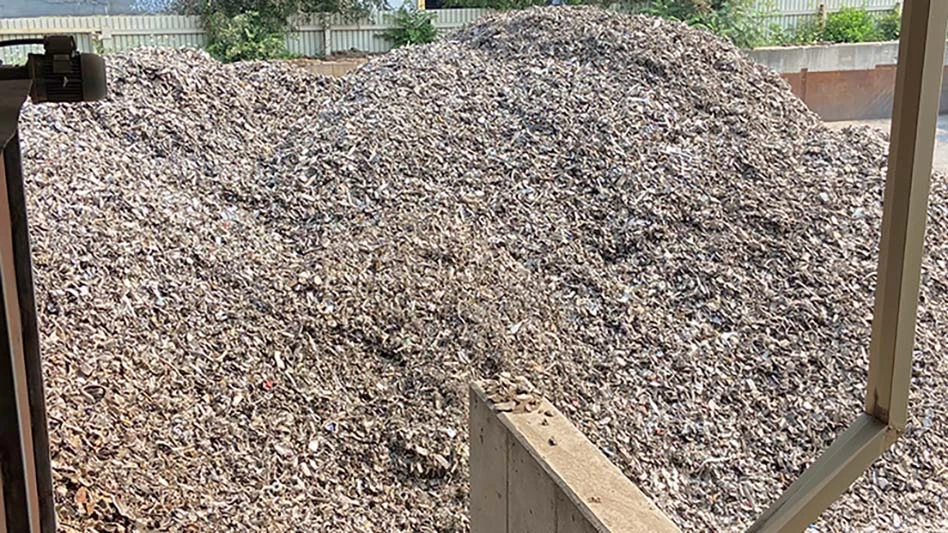Where scrap handler maintenance ends, attachment maintenance begins. While it is generally agreed that certain types of attachments require more maintenance than others, the life of any attachment can be prolonged if basic maintenance tasks are performed.
KEEPING MAGNETS MAGNETIZED
When viewed from underneath, a magnet looks like a large, practically indestructible slab of metal. In reality, though, there are several mechanical and electrical parts that allow a lifting magnet to perform its “magic,” and even the bottom plate must be inspected for cracks and other signs of damage.
According to one magnet manufacturing product manager, regular inspections of magnetic attachments are critical in identifying small problems before they become major repair projects. A regular inspection schedule and routine is recommended by most magnet manufacturers.
Among the possible hazards to look for are dents in the magnet case, broken welds in the lifting lugs and chain, signs of leakage into the terminal box, and accumulations of dirt virtually anywhere on the magnetic attachment. In addition to a visual inspection, some further testing can be done an electrical components using such devices as an Ohmmeter.
Operators and manufacturers alike note that the shopping around stage is the first place to start thinking in terms of durability and ongoing maintenance.
An initial area to examine is that seemingly indestructible bottom plate, and in particular the thickness of the plate. The bottom plate, which covers the magnet’s coil, is not a primary magnet surface, and serves mainly to keep out moisture and to hold the dead weight of the coils. According to one manufacturer, as much as 75% of the damage to burned-out magnets can be attributed to bottom plate trauma, often caused by the chronic practice of using the magnet as a dead weight. (Thickness at the top of the magnet is important also, some contend, because the casing at the top—consisting of the riser and the head—must be able to force the magnetism downward.)
“Processors and operators should not look at magnets as indestructible,” one engineer notes. “These are carefully engineered electromagnets composed of several sub-components that can bruise, bend or break.” When operators use the magnet as dead weight to smash or break scrap, this could seriously damage the magnet.
One feature to look for or request is hardened surface treatment around the edges of the magnet to protect it better when banging against a truck, a gondola car or against scrap.
Any protection lifting magnet owners can offer from the elements can also be helpful in ensuring longer magnet life. Operators can be mindful of external influences such as heat and moisture that can effect the resistance values of the winding, and ultimately affect the performance of the magnet.
Overheating can also come from improper use. Processors should track the duty cycle of the magnet and be aware of how that magnet is performing. If the magnet is being energized too long, a situation occurs called a “long lift” where the magnet does not have enough time to cool down and has generated more heat than it can dissipate. As the heat builds up, resistance increases and lifting power decreases proportionally in accordance with Ohm’s Law. So if left to build up, the added high temperature and the resulting added voltage will increase to a point where it can destroy the magnet.
While damage is bound to occur over time, paying close attention to the magnet’s condition and adhering to a maintenance schedule can help avoid a severe breakdown.
GRAPPLING WITH WEAR AND TEAR
Grapples—whether of an orange peel, tulip or other configuration—are designed to handle anything that comes their way. By and large, manufacturers have hardened the tips of the tines to prolong wear, since these are the areas that receive the most abuse. But even the hardened metal found on grapples can suffer a crack after grinding through enough metal-to-metal contact.
Above the tines, there are areas that require the same vigilant attention to maintenance needed with all other types of heavy equipment. Hydraulic lines must be inspected regularly and replaced periodically. Hydraulic cylinders are also parts that endure a predicable amount of wear, and should thus be inspected regularly and replaced as needed.
Pin locations are another area that need attention, including regularly scheduled lubrication. Pins can also develop cracks or become misshapen.
Scrap handler operators with shear attachments, as part of their maintenance routine, must keep a close eye on the sharpness and general condition of shear blades. As with virtually any cutting or shearing device, the blades are the part subjected to the greatest degree of wear and tear.
Many manufacturers have addressed shear blade wear by using “super hard” wear-resistant steels and by installing four-way reversible cutting blades.
Get curated news on YOUR industry.
Enter your email to receive our newsletters.

Explore the June 1998 Issue
Check out more from this issue and find your next story to read.
Latest from Recycling Today
- Ship dismantlers navigate new regulatory regimen
- Gershow announces several community involvement projects
- McKinsey identifies engineering polymers as a recycling opportunity
- Metso acquisition focuses on mill liner recycling
- Malaysian customs office seizes scrap containers
- Lindner establishes Brazil subsidiary
- Tire recycling veteran predicts growth in pyrolysis
- ShearCore adds FC95 to concrete processor line





